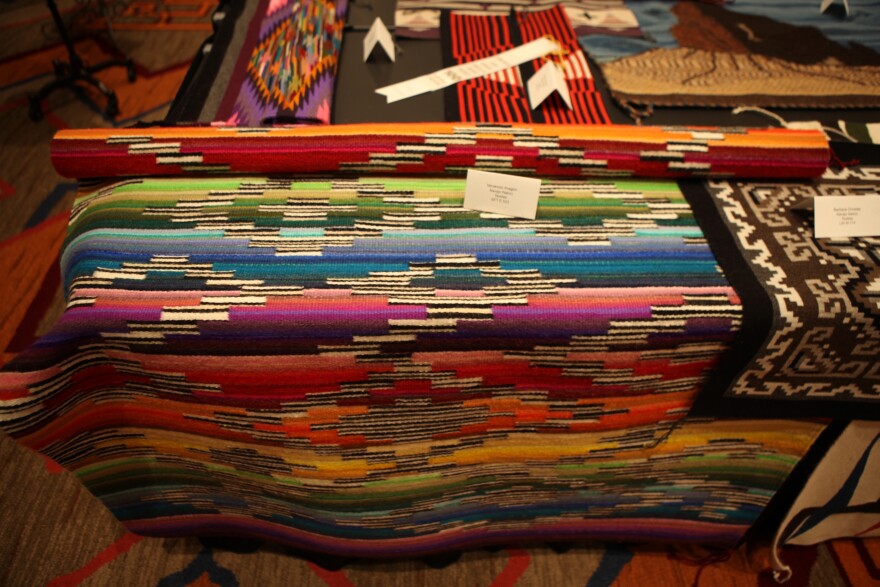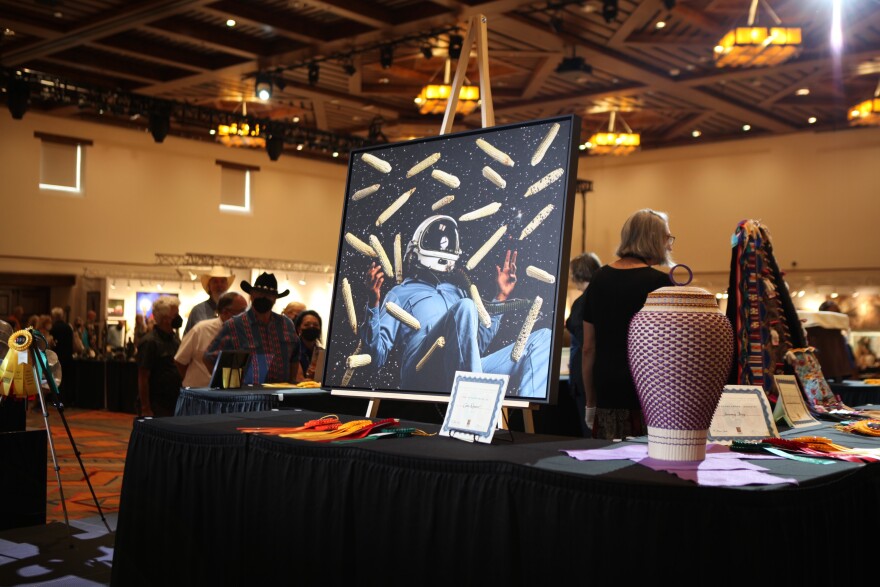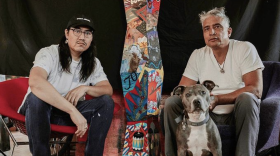The Friday before Indian Market, the Santa Fe Community Convention Center was filled with paintings, sculpture, beadwork, jewelry and more.
Contemporary works won prizes, like Cara Romero's photograph of an astronaut surrounded by corn which won the Best of Class Award in the 2D category, alongside more traditional works like the polychrome jar by Russell Sanchez of San Ildefonso Pueblo, which won Best of Show overall.
"I'm just blown away, I mean, artistically and creatively, seeing the craftsmanship, seeing the intricacy," said Jeff Suina, a potter from Cochiti Pueblo who uses traditional techniques alongside computer design to make angular, asymmetrical pots.

This was the first full Santa Fe Indian Market since 2019, the event was canceled because of the pandemic in 2020 and held in a reduced form last year. About 1,000 Native artists gathered in Santa Fe, despite heavy rain on Saturday, to show and sell their work.
"I think it's bustling. I think there's a really good vibe," said Suina. "Almost like relief maybe because it signifies a return back to what it was before."
Like many here, Suina's personal history stretches right back to the beginning of the market. His great grandmother Tonita Peña was a painter whose work at the market was famous around 100 years ago.
One of Peña's works is part of an exhibition at the New Mexico History Museum, commemorating the market's centennial. The show opens with a mural taken from a photograph by William Henry Jackson in 1902, showing tourists coming through Laguna Pueblo train station, buying souvenirs from Native people.
"There was an increase beginning in the 1880s in tourism to the southwest," explained curator Cathy Notarnicola.
With the expansion of the railroad also came new experiences for people in the area, like traveling opera and circus companies. Native people began to use traditional pottery techniques to make figurines of opera singers or acrobats, to sell cheaply to tourists.
But the first head of the New Mexico History Museum, Edgar Lee Hewett, along with anthropologist Kenneth Chapman, was worried about what they saw, said Notarnicola. They called the figurines curios and viewed them as, "as non traditional, even though they were made by Natives, who grew up making pottery in the traditional way".
So Hewett and Chapman sponsored a market as part of the annual Fiestas de Santa Fe that was meant to create a market for Indian art, but only what they decided was traditional. Figurines were not permitted at the market and the artists didn't sell directly to buyers until the late 1930s.
"You see a bit of a paternalistic attitude by the museum staff," said Notarnicola.
But innovation happened despite the push to preserve Native traditions exactly as they were. For example the potter Maria Martinez and her husband, Julian, from San Ildefonso Pueblo, invented a new way of firing that meant they could create pots with a shiny black design on a matte black background, what is now known as black-on-black pottery.
"That was definitely innovative at one time, but now, it's considered to be traditional," said Notarnicola.
Suina, the potter from Cochiti Pueblo, said his great grandmother's paintings were sometimes controversial during her time, because they depicted aspects of Pueblo life some considered private. He said originality is part of being an artist, and has always been part of Indian Market.
"I think innovation is the breath of this whole industry, being able to express ideas in a new way but with tried and true techniques and elements," he said.
Now, the executive director of SWAIA, the organization that runs Indian Market, is Kim Peone of the Colville Confederated Tribes and Eastern Band of Cherokee Indians. Tradition is still an important part of the event but she looks beyond that.
"We are in the fine arts, we are in the contemporary arts, we are those artists, and to keep us in a space of antiquities is incorrect," she said.
At the Santa Fe Plaza on Saturday, the market was vibrant despite lots of rain. Contemporary artworks were on display next to more traditional ones. Navajo weaver Venancio Aragon and his mother had a booth full of weavings in rainbow colors. They use a mix of natural and synthetic dyes.

"A lot of the modern artists today really challenged the conventions of their traditional culture and things that their ancestors created," he said.
When the market began, only artists from New Mexico were invited. Now people come from all over the US and Canada. Aragon calls the market almost a decolonized version of what it once was
"The Native artists are the forefront of the voice of Indian market, giving their interpretations of their culture, their art, and really speaking for themselves."
This reporting was supported by the W. K. Kellogg foundation and KUNM listeners






